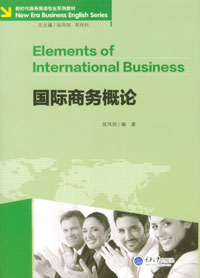
作为商务英语专业国际商务知识类主干课程教材,本书系统地介绍了国际商务主要领域的基本知识和发展的最新动态,注重实用。除了商务英语专业学生以外,本书还适合国际商务、经济、管理、金融等涉外专业的大学生、研究生及工商管理硕士生(MBA)使用。本书用简单的英语写成,通俗易懂。通过使用本书,学生既能获得国际商务核心知识,又能提升国际商务英语水平,可谓一举两得。
Chapter 1General View of International Business
国际商务概述
1.1What Is International Business?
何谓国际商务?
1.2Why Do We Study International Business?
为何学习国际商务?
1.3International Business and International Trade
国际商务与国际贸易
1.4Modes of International Business
国际商务形式
1.5The Need for Conducting International Business
从事国际商务的必要性
1.6Modern International Business Study
现代国际商务研究
1.7Why Do Companies Engage in International Business?
公司介入国际商务之原因
1.8Globalization
全球化
1.9Internationalization
国际化
1.10The GATT and the WTO
关税与贸易总协定及世界贸易组织
1.11China in International Business Arena
国际商务舞台上的中国
Chapter 2The Framework of International Business
国际商务框架
2.1Levels of Economic Integration
经济一体化的层次
2.2The Triad
三足鼎立 (三大区域)
2.3Outside the Triad
三大区域之外
Chapter 3Culture and International Business
文化与国际商务
3.1What Is Culture?
何谓文化?
3.2Layers of Culture
文化层面
3.3Reasons for the Differences Between Cultures
文化差异的原因
3.4Cultural Conflicts in International Business
国际商务中的文化碰撞
3.5Corporate Culture and National Culture
企业文化与民族文化
3.6Cultural Conflicts and Multinational Companies (MNCs)
文化碰撞与跨国公司
Chapter 4International Business Environment
国际商务环境
4.1The Economic Environment
经济环境
4.2The Political Environment
政治环境
4.3The Legal Environment
法律环境
4.4The Sociocultural Environment
社会文化环境
4.5The Technological Environment
技术环境
4.6The Financial Environment
金融环境
4.7The Information Environment
信息环境
4.8The Internal Environment
内部环境
Chapter 5International Trade
国际贸易
5.1What Is International Trade?
何谓国际贸易?
5.2How Did International Trade Start?
国际贸易的起源
5.3The Benefits, Structure of, and Reasons for International Trade
国际贸易的利益、 结构及原因
5.4International Trade in the Framework of the World Economy
世界经济框架中的贸易
5.5Incoterms
《国际贸易术语通则》
5.6Documentation of Export
出口单证
Chapter 6International Marketing
国际营销
6.1The Nature of Marketing
营销的本质
6.2Domestic Marketing and International Marketing
国内营销与国际营销
6.3Reasons for Marketing Abroad
海外营销的原因
6.4Market
市场
6.5International Marketing Environment
国际营销环境
6.6Marketing Strategy
营销战略
6.7Integrated Marketing
整合营销
6.8Direct Marketing
直接营销
6.9Positioning
定位
6.10Differentiation
差异化营销
6.11Personal Selling
推销
6.12AIDA
“爱达”
6.13FABV
“发步”
6.14SWOT and PEST Analysis Templates
SWOT(态势)和PEST(宏观环境)分析模型
6.15Branding
品牌策略
6.16Unique Selling Proposition (USP)
独特的销售方式
6.17Word-of-mouth
口碑效应
6.18Marketing Mix—the 4 Ps
营销组合: 4Ps
Chapter 7International Finance
国际金融
7.1The Role of Central Banks
中央银行的作用
7.2International Monetary System (IMS)
国际货币体系
7.3Balance of Payments (BOP)
国际收支
7.4Foreign Exchange
外汇
7.5US Dollar, British Pound, the Euro, and RMB
美元、英镑、欧元和人民币
7.6International Money Markets
国际货币市场
7.7Eurobond Market
欧洲债券市场
7.8International Stock Markets
国际证券市场
7.9The Asian Development Bank (ADB)
亚洲开发银行
7.10The Asian Infrustructure Investment Bank (AIIB)
亚洲基础设施投资银行
Chapter 8International Accounting, Auditing and Tax
国际会计、 国际审计和国际税收
8.1General View of International Accounting
国际会计概述
8.2International Accounting and International Business
国际会计与国际商务
8.3The Field of International Accounting
国际会计的领域
8.4Classifications of Accounting Systems
国际会计制度的分类
8.5Principal Accounting Differences Between Countries
各国间会计的主要差别
8.6International Accounting Harmonization
国际会计协调
8.7The International Accounting Standards Board (IASB, formerly IASC)
国际会计标准委员会
8.8International Accounting Transparency and Disclosure
国际会计透明与公开
8.9Foreign Currency Translation
外币换算
8.10Accounting for Changing Prices
变化价格会计
8.11International Financial Statement Analysis
国际财务报表分析
8.12International Auditing
国际审计
8.13China’s Accounting and Auditing
中国的财会与审计
8.14International Taxation
国际征税
Chapter 9Multinational Enterprises
跨国企业
9.1The Nature of Multinational Enterprises (MNEs)
跨国企业的性质
9.2Characteristics of an MNE
跨国企业的特点
9.3The Reasons for Companies’ Becoming Multinational Enterprises
公司转型为跨国企业之原因
9.4Using the OECD Guidelines for Multinational Enterprises
将经济合作与发展组织的准则应用于跨国企业
9.5The Impact of Multinational Enterprises
跨国企业的影响
9.6Multinational Enterprises and Trade Theory
跨国企业与贸易理论
9.7The Role and Place of Multinational Enterprises in Export
Processing Zones (EPZs)
跨国企业在出口加工区的作用与地位
9.8MNEs in Developing Countries
发展中国家的跨国企业
9.9China’s Multinational Enterprises
中国的跨国企业
Chapter 10Foreign Direct Investment (FDI)
对外直接投资
10.1The Nature of FDI
对外直接投资的性质
10.2Reasons for FDI
对外直接投资的原因
10.3Theories of FDI
对外直接投资理论
10.4Advantages of FDI
对外直接投资的利益
10.5Strategies for FDI
对外直接投资战略
10.6Costs of FDI
对外直接投资的成本
10.7Diversification
多元化经营
10.8FDI Decision Making
对外直接投资决策
10.9FDI Inside and Outside China
中国境内外直接投资
10.10China’s Outbound FDI
中国的对外直接投资
Chapter 11Human Resource Management
人力资源管理
11.1General View of Human Resource Management (HRM)
人力资源管理概述
11.2What Is International HRM?
何谓国际人力资源管理?
11.3Country Nationals
国民
11.4Global Staffing Policies and Strategy
全球员工配备政策与策略
11.5Training and Development
培训与发展
11.6Expatriates
外派人员
11.7Compensation
报酬
11.8Labour Relations
劳资关系
11.9The Role of Union
工会的作用
11.10Organization Structure of the MNE
跨国企业组织结构
11.11Culture Shock
文化冲击
Chapter 12International Logistics
国际物流
12.1Nature of Logistics
国际物流的性质
12.2New Concept of 21st Century Logistics
21世纪国际物流新概念
12.3Components of a Logistics System
物流系统的组成部分
12.4The Role of Logistics in the Economy
物流在经济中的作用
12.5Logistics in the Organization
企业中的物流
12.6Domestic Logistics and International Logistics
国内物流与国际物流
12.7Key Logistics Activities
物流的主要内容
12.8When Does International Logistics Occur?
什么情况下会出现国际物流?
12.9International Sourcing, Third Party Logistics (TPL) and Fourth Party Logistics (FPL)
国际采购与第三方物流和第四方物流
12.10Managing Materials Flow
材料流动管理
12.11Inventory
存货
12.12Warehousing
仓储
12.13Transportation in Logistics
物流环节中的运输
Chapter 13Electronic Commerce
电子商务
13.1What Is Electronic Commerce (E-Commerce, EC)?
何谓电子商务?
13.2A Brief History of EC
电子商务历史概述
13.3Classification of the EC Field by the Nature of the Transactions
基于交易性质的电子商务分类
13.4EC Applications
电子商务应用
13.5Advantages and Disadvantages of EC
电子商务的利弊
13.6The Internet, the Intranet, the Extranet, and the World Wide Web
因特网、 内联网、 外联网及万维网
13.7Electronic Data Interchange (EDI) and the Internet
电子数据交换与因特网
13.8Types of Interorganizational Systems
组织内部系统的种类
13.9E-commerce in the International Trade Arena
国际贸易环境中的电子商务
13.10E-marketing (EM)
电子营销
13.11M-commerce
移动电子商务
Chapter 14International Business Law
国际商法
14.1A Brief Introduction to Civil Law System
大陆法系简介
14.2Codification
法典化
14.3A Brief Introduction to Common Law System
普通法系简介
14.4Basic Principles of Common law
普通法系基本原则
14.5Common Law as a Foundation for Commercial Economies
普通法系:商务经济体的基础
14.6About Corporate Law and Its History
公司法及其历史
Chapter 15International Payments
国际支付
15.1The Significance of International Payments
国际支付的意义
15.2Risks in International Payments
国际支付风险
15.3Terms of Payment
支付条件
15.4The Importance of a Contract in International Payments
合同在国际支付中的重要性
15.5Letter of Credit
信用证
15.6Collection
托收
15.7Bill of Exchange
汇票
15.8Promissory Note
本票
15.9Cheque
支票
15.10Remittance
汇付
15.11International Factoring
国际保理
References
参考文献